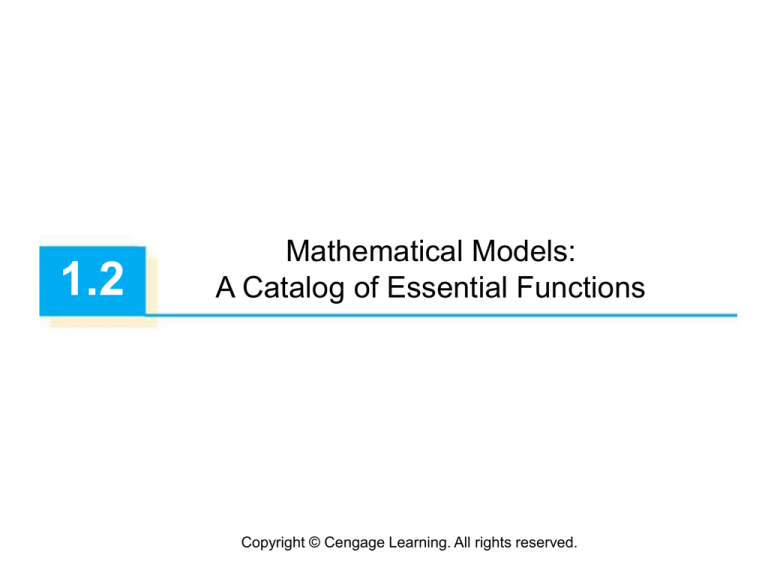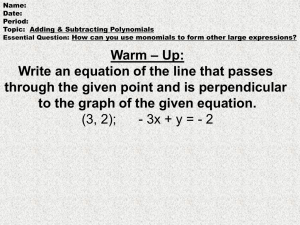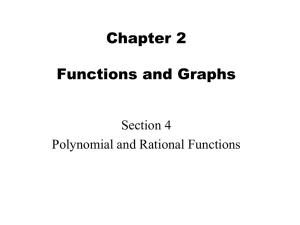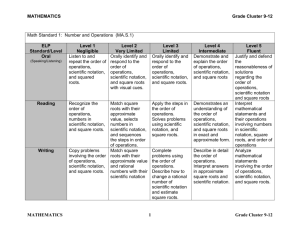
1.2
Mathematical Models:
A Catalog of Essential Functions
Copyright © Cengage Learning. All rights reserved.
Linear Models
When we say that y is a linear function of x, we mean that
the graph of the function is a line, so we can use the
slope-intercept form of the equation of a line to write a
formula for the function as
y = f(x) = mx + b
where m is the slope of the line and b is the y-intercept.
7
Linear Models
A characteristic feature of linear functions is that they grow
at a constant rate.
For instance, Figure 2 shows a graph of the linear function
f(x) = 3x – 2 and a table of sample values.
Figure 2
8
Polynomials
15
Polynomials
A function P is called a polynomial if
P(x) = anxn + an–1xn–1 + . . . + a2x2 + a1x + a0
where n is a nonnegative integer and the numbers
a0, a1, a2, . . ., an are constants called the coefficients of
the polynomial.
The domain of any polynomial is
If the leading
coefficient an 0, then the degree of the polynomial is n.
For example, the function
is a polynomial of degree 6.
16
Polynomials
A polynomial of degree 1 is of the form P(x) = mx + b and
so it is a linear function.
A polynomial of degree 2 is of the form P(x) = ax2 + bx + c
and is called a quadratic function.
17
Polynomials
Its graph is always a parabola obtained by shifting the
parabola y = ax2. The parabola opens upward if a > 0 and
downward if a < 0. (See Figure 7.)
The graphs of quadratic functions are parabolas.
Figure 7
18
Polynomials
A polynomial of degree 3 is of the form
P(x) = ax3 + bx2 + cx + d
a0
and is called a cubic function. Figure 8 shows the graph
of a cubic function in part (a) and graphs of polynomials of
degrees 4 and 5 in parts (b) and (c).
Figure 8
19
Power Functions
25
Power Functions
A function of the form f(x) = xa, where a is a constant, is
called a power function. We consider several cases.
(i) a = n, where n is a positive integer
The graphs of f(x) = xn for n = 1, 2, 3, 4, and 5 are shown in
Figure 11. (These are polynomials with only one term.)
We already know the shape of the graphs of y = x (a line
through the origin with slope 1) and y = x2 (a parabola).
26
Power Functions
Graphs of f(x) = xn for n = 1, 2, 3, 4, 5
Figure 11
27
Power Functions
Notice from Figure 12, however, that as n increases, the
graph of y = xn becomes flatter near 0 and steeper when
|x| 1. (If x is small, then x2 is smaller, x3 is even smaller,
x4 is smaller still, and so on.)
Families of power functions
Figure 12
29
Power Functions
(ii) a = 1/n, where n is a positive integer
The function
is a root function. For n = 2
it is the square root function
whose domain is
[0, ) and whose graph is the upper half of the
parabola x = y2. [See Figure 13(a).]
Graph of root function
Figure 13(a)
30
Power Functions
For other even values of n, the graph of
to that of
is similar
For n = 3 we have the cube root function
whose
domain is (recall that every real number has a cube root)
and whose graph is shown in Figure 13(b). The graph of
for n odd (n > 3) is similar to that of
Graph of root function
Figure 13(b)
31
Power Functions
(iii) a = –1
The graph of the reciprocal function f(x) = x –1 = 1/x is
shown in Figure 14. Its graph has the equation y = 1/x, or
xy = 1, and is a hyperbola with the coordinate axes as its
asymptotes.
The reciprocal function
Figure 14
32
Rational Functions
34
Rational Functions
A rational function f is a ratio of two polynomials:
where P and Q are polynomials.
The domain consists of all values
of x such that Q(x) 0.
A simple example of a rational
function is the function f(x) = 1/x,
whose domain is {x|x 0}; this
is the reciprocal function graphed
in Figure 14.
The reciprocal function
Figure 14
35
Algebraic Functions
37
Algebraic Functions
A function f is called an algebraic function if it can be
constructed using algebraic operations (such as addition,
subtraction, multiplication, division, and taking roots)
starting with polynomials. Any rational function is
automatically an algebraic function.
Here are two more examples:
38
Algebraic Functions
The graphs of algebraic functions can assume a variety of
shapes. Figure 17 illustrates some of the possibilities.
Figure 17
39
Trigonometric Functions
41
Trigonometric Functions
In calculus the convention is that radian measure is always
used (except when otherwise indicated).
For example, when we use the function f(x) = sin x, it is
understood that sin x means the sine of the angle whose
radian measure is x.
42
Trigonometric Functions
Thus the graphs of the sine and cosine functions are as
shown in Figure 18.
(a) ƒ(x) = sin x
(b) g(x) = cos x
Figure 18
43
Trigonometric Functions
The tangent function is related to the sine and cosine
functions by the equation
and its graph is shown in
Figure 19. It is undefined
whenever cos x = 0, that is,
when x = /2, 3 /2, . . . .
y = tan x
Its range is (
,
).
Figure 19
46
Exponential Functions
48
Exponential Functions
The exponential functions are the functions of the form
f(x) = ax, where the base a is a positive constant.
The graphs of y = 2x and y = (0.5)x are shown in Figure 20.
In both cases the domain is (
, ) and the range is
(0, ).
(a) y = 2x
(b) y = (o.5)x
Figure 20
49
Logarithmic Functions
51
Logarithmic Functions
The logarithmic functions f(x) = logax, where the base a is a
positive constant, are the inverse functions of the exponential
functions. Figure 21 shows the graphs of four logarithmic
functions with various bases.
In each case the domain is
(0, ), the range is (
, ),
and the function increases
slowly when x > 1.
Figure 21
52












